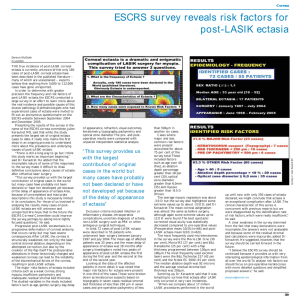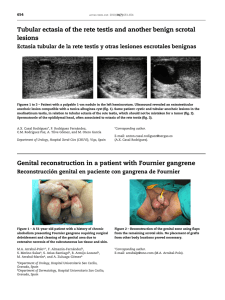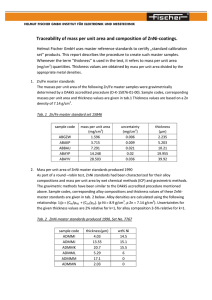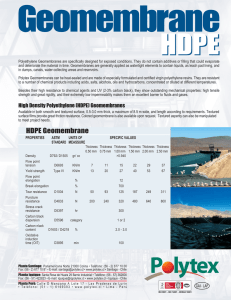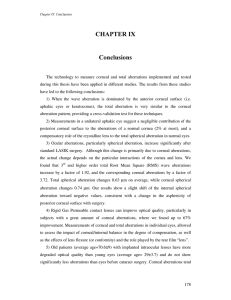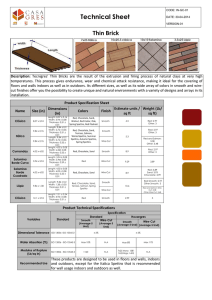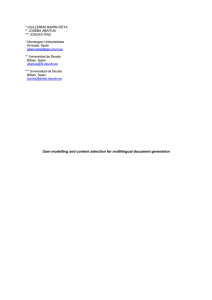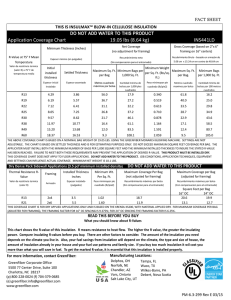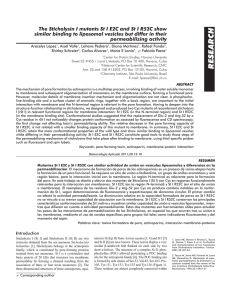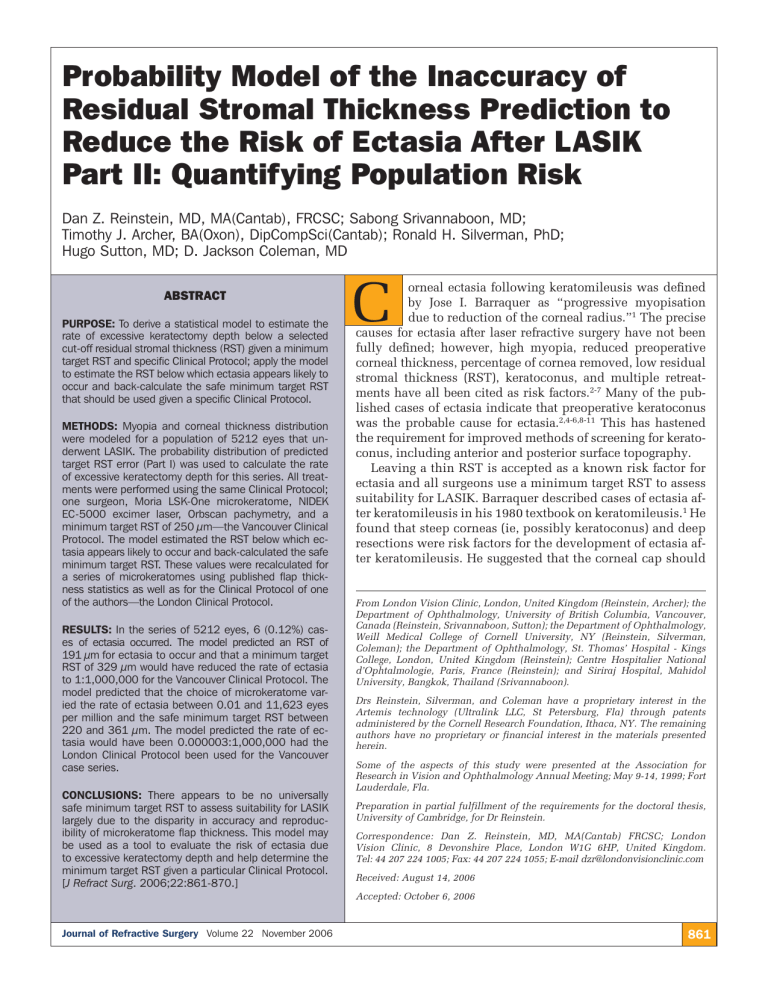
Probability Model of the Inaccuracy of Residual Stromal Thickness Prediction to Reduce the Risk of Ectasia After LASIK Part II: Quantifying Population Risk Dan Z. Reinstein, MD, MA(Cantab), FRCSC; Sabong Srivannaboon, MD; Timothy J. Archer, BA(Oxon), DipCompSci(Cantab); Ronald H. Silverman, PhD; Hugo Sutton, MD; D. Jackson Coleman, MD ABSTRACT PURPOSE: To derive a statistical model to estimate the rate of excessive keratectomy depth below a selected cut-off residual stromal thickness (RST) given a minimum target RST and specific Clinical Protocol; apply the model to estimate the RST below which ectasia appears likely to occur and back-calculate the safe minimum target RST that should be used given a specific Clinical Protocol. METHODS: Myopia and corneal thickness distribution were modeled for a population of 5212 eyes that underwent LASIK. The probability distribution of predicted target RST error (Part I) was used to calculate the rate of excessive keratectomy depth for this series. All treatments were performed using the same Clinical Protocol; one surgeon, Moria LSK-One microkeratome, NIDEK EC-5000 excimer laser, Orbscan pachymetry, and a minimum target RST of 250 µm—the Vancouver Clinical Protocol. The model estimated the RST below which ectasia appears likely to occur and back-calculated the safe minimum target RST. These values were recalculated for a series of microkeratomes using published flap thickness statistics as well as for the Clinical Protocol of one of the authors—the London Clinical Protocol. RESULTS: In the series of 5212 eyes, 6 (0.12%) cases of ectasia occurred. The model predicted an RST of 191 µm for ectasia to occur and that a minimum target RST of 329 µm would have reduced the rate of ectasia to 1:1,000,000 for the Vancouver Clinical Protocol. The model predicted that the choice of microkeratome varied the rate of ectasia between 0.01 and 11,623 eyes per million and the safe minimum target RST between 220 and 361 µm. The model predicted the rate of ectasia would have been 0.000003:1,000,000 had the London Clinical Protocol been used for the Vancouver case series. CONCLUSIONS: There appears to be no universally safe minimum target RST to assess suitability for LASIK largely due to the disparity in accuracy and reproducibility of microkeratome flap thickness. This model may be used as a tool to evaluate the risk of ectasia due to excessive keratectomy depth and help determine the minimum target RST given a particular Clinical Protocol. [J Refract Surg. 2006;22:861-870.] C orneal ectasia following keratomileusis was defined by Jose I. Barraquer as “progressive myopisation due to reduction of the corneal radius.”1 The precise causes for ectasia after laser refractive surgery have not been fully defined; however, high myopia, reduced preoperative corneal thickness, percentage of cornea removed, low residual stromal thickness (RST), keratoconus, and multiple retreatments have all been cited as risk factors.2-7 Many of the published cases of ectasia indicate that preoperative keratoconus was the probable cause for ectasia.2,4-6,8-11 This has hastened the requirement for improved methods of screening for keratoconus, including anterior and posterior surface topography. Leaving a thin RST is accepted as a known risk factor for ectasia and all surgeons use a minimum target RST to assess suitability for LASIK. Barraquer described cases of ectasia after keratomileusis in his 1980 textbook on keratomileusis.1 He found that steep corneas (ie, possibly keratoconus) and deep resections were risk factors for the development of ectasia after keratomileusis. He suggested that the corneal cap should From London Vision Clinic, London, United Kingdom (Reinstein, Archer); the Department of Ophthalmology, University of British Columbia, Vancouver, Canada (Reinstein, Srivannaboon, Sutton); the Department of Ophthalmology, Weill Medical College of Cornell University, NY (Reinstein, Silverman, Coleman); the Department of Ophthalmology, St. Thomas’ Hospital - Kings College, London, United Kingdom (Reinstein); Centre Hospitalier National d’Ophtalmologie, Paris, France (Reinstein); and Siriraj Hospital, Mahidol University, Bangkok, Thailand (Srivannaboon). Drs Reinstein, Silverman, and Coleman have a proprietary interest in the Artemis technology (Ultralink LLC, St Petersburg, Fla) through patents administered by the Cornell Research Foundation, Ithaca, NY. The remaining authors have no proprietary or financial interest in the materials presented herein. Some of the aspects of this study were presented at the Association for Research in Vision and Ophthalmology Annual Meeting; May 9-14, 1999; Fort Lauderdale, Fla. Preparation in partial fulfillment of the requirements for the doctoral thesis, University of Cambridge, for Dr Reinstein. Correspondence: Dan Z. Reinstein, MD, MA(Cantab) FRCSC; London Vision Clinic, 8 Devonshire Place, London W1G 6HP, United Kingdom. Tel: 44 207 224 1005; Fax: 44 207 224 1055; E-mail [email protected] Received: August 14, 2006 Accepted: October 6, 2006 Journal of Refractive Surgery Volume 22 November 2006 861 Safety Model for Preventing Ectasia/Reinstein et al Figure 1. Artemis VHF digital ultrasound horizontal B-scan of a cornea with a flap created with a Hansatome 160. The B-scan demonstrates interfaces detected ultrasonically for the epithelial surface (E), surface of Bowman’s interface (B), lamellar flap interface (F), and endothelial/posterior corneal surface (P). Centrally the flap was measured as 323 µm, which was 163 µm thicker than the predicted flap thickness of 160 µm. be a maximum of 300-µm thick as a safety criterion for reducing the risk of ectasia in keratomileusis. This translates to using a minimum target RST of approximately 250 µm assuming an average corneal thickness of 550 µm (by slit-lamp optical pachymetry used at that time12). Although 250 µm remains the widely accepted minimum target RST for suitability for LASIK,13,14 some reports suggest that this should be higher15-17 and others demonstrate that it could be lower.18 The standard deviation of flap thickness can be up to (or even above) 30 µm for some commercially available microkeratomes.19-22 With a flap thickness standard deviation of 30 µm, an RST error of 90 µm is likely to occur in 0.5% of eyes (99% of values lie within 3 standard deviations for a Normal distribution). Spadea et al23 reported a case of ectasia where a Moria manually guided MDSC microkeratome (Moria, Antony, France) with a predicted flap thickness of 120 µm was used. The flap was measured histologically as 260 µm; an error of 140 µm. Figure 1 shows an Artemis VHF digital ultrasound B-scan (Ultralink LLC, St Petersburg, Fla) of a LASIK flap created with a Hansatome 160 microkeratome (Bausch & Lomb, Rochester, NY). The predicted flap thickness was 160 µm and the flap was measured to be 323-µm-thick centrally; an error of 163 µm. Granted that this case may represent user error such as excess vacuum and/or excess downward pressure during passage of the microkeratome head. There are reported cases of ectasia where no evidence of keratoconus was present and the predicted RST was 250 µm.3,24 However, with the potential for RST errors of 100 µm, it is possible that some of the undetermined cases of ectasia in the literature could be explained by unexpected excessive keratectomy depth. It seems to be difficult to draw conclusions about the cause of ectasia from the predicted RST without a direct measurement of the RST. Other etiological factors 862 may contribute to ectasia but for the purposes of this article, we have assumed that the two principle causes are: 1) undetected keratoconus and 2) excessive keratectomy depth leaving a low RST. In Part I of this work, we derived the probability of obtaining an actual RST below a selected cut-off RST given the predicted target RST for an individual eye. In Part II, we set out to apply this probability to statistically model the percentage of eyes that would be expected to have an actual RST below the selected cutoff RST for a given population of eyes (range of myopia and corneal thickness) and LASIK Clinical Protocol (microkeratome, pachymeter, laser, and surgical protocols). We describe how the model can be used to back-calculate the minimum target RST that might be used to reduce the risk of excessive keratectomy depth to clinically acceptable levels for a given Clinical Protocol. We also describe a method of obtaining a theoretical estimate of the cut-off RST below which ectasia appears likely to occur due to excessive keratectomy depth. The model was applied to a number of example Clinical Protocols to demonstrate how the methods described can be applied in practice and investigate how different microkeratomes might affect the potential rate of ectasia due to excessive keratectomy depth. MATERIALS AND METHODS OVERVIEW We have described a model, the “RST model,” that provides a continuous probability function describing the chance of obtaining an actual RST less than a selected cut-off RST given a predicted target RST.25 This was done by modeling the error of the predicted target RST as a Normal distribution using the statistically combined bias (accuracy) and uncertainty (standard deviation) of corneal thickness measurement, flap journalofrefractivesurgery.com Safety Model for Preventing Ectasia/Reinstein et al thickness, and ablation depth. The probability of obtaining an actual RST less than a selected cut-off RST gets smaller as the predicted target RST increases.25 In practice, the population of eyes presenting for refractive surgery will cover a wide range of predicted target RSTs depending on the corneal thickness and level of myopia to be treated. Therefore, if the “RST model” is individually applied to each eye in the population, the sum of these probabilities will represent the percentage of eyes that would be expected to have an actual RST below the selected cut-off RST given the particular Clinical Protocol. The probability output by the model is subsequently referred to as the predicted rate of excessive keratectomy depth. STATISTICAL MODEL FOR THE PERCENTAGE OF EYES WITH LOW RST FOR A SPECIFIC POPULATION AND EQUIPMENT Modeling Parameters to Represent a Clinical Protocol. As with the “RST model” from Part I, the model described below includes a number of parameters so that it can be customized to represent the instruments and protocols used in the particular refractive surgery practice. Throughout the article, the set of parameters that can be changed (listed below) are defined as the Clinical Protocol. ● Minimum target RST used to assess suitability for LASIK. ● Selected cut-off RST. ● Minimum and maximum corneal thickness used to assess suitability for LASIK. ● Minimum and maximum level of myopia. ● Mean, standard deviation, and labeled flap thickness of the microkeratome (assuming that the same microkeratome is used for all eyes). ● The bias (accuracy) and standard deviation of the method of corneal thickness measurement. ● The standard deviation and the linear regression equation for the bias (accuracy) of the laser ablation depth. Modeling Parameters to Represent the Distribution of Myopia and Corneal Thickness. To calculate the percentage of eyes with each predicted target RST, the distribution of myopia relative to the distribution of corneal thickness needs to be modeled. Ideally, the percentage of eyes for each combination of corneal thickness and maximum myopic meridian (corresponding to the ablation depth) would be calculated, but for simplicity of use, the distributions of corneal thickness and level of myopia have been separated. The distribution of myopia was modeled as a histogram using 0.25-diopter (D) groups; the percentage of eyes for each level of myopia can be manually entered into the model. This allows flexibility for the distribuJournal of Refractive Surgery Volume 22 November 2006 tion of myopia treated in a refractive surgery practice. Alternatively, the user can select a default distribution of myopia for a representative population of eyes presenting for refractive surgery. The mean and standard deviation of corneal thickness can be adjusted to reflect the population of eyes being treated. The model assumes that corneal thickness is Normally distributed and independent of refraction as has been previously published.26,27 The distributions of corneal thickness and myopia can then be combined as a table, with the values in the table representing the percentage of eyes for each particular combination, calculated by multiplying the percentages for the corresponding corneal thickness and myopia. Modeling the Percentage of Patients Deemed Suitable for Surgery. The percentage of patients who are turned down for LASIK for reasons relating to corneal thickness is affected by the Clinical Protocol. For example, using a lower minimum target RST or using a microkeratome with a thinner-labeled flap thickness would reduce the percentage of eyes turned down for LASIK. The table of corneal thickness against level of myopia is filtered to exclude any combinations that do not satisfy the inclusion criteria according to the Clinical Protocol. Specifically, the combination of corneal thickness and level of myopia should satisfy 1) predicted target RST minimum target RST, 2) corneal thickness minimum corneal thickness, and 3) myopia treated maximum myopia treated. The percentages for the suitable combinations of corneal thickness and level of myopia in this table are summed to find the percentage of eyes that would be suitable for LASIK for the specific Clinical Protocol. Once the inclusion criteria have been applied, the filtered distribution of corneal thickness and myopia is scaled up to 100% to represent the distribution of eyes receiving treatment; a second table multiplies each value in the filtered table by (100/percentage of suitable eyes) to obtain the scaled distribution. Calculating the Predicted Rate of Excessive Keratectomy. A third table contains the result of the “RST model” applied to each combination of corneal thickness and level of myopia, ie, the probability of obtaining an actual RST below the selected cut-off RST given the predicted target RST. This table can be used to look up this probability for an individual case. Finally, a fourth table multiplies the percentages in the table representing the scaled distribution of corneal thickness and level of myopia by the probability of obtaining an actual RST below the selected cut-off RST given the predicted target RST. The values in this table are summed to obtain the rate of excessive keratectomy depth to less than the selected cut-off RST for the given population of eyes and Clinical Protocol. 863 Safety Model for Preventing Ectasia/Reinstein et al A screen shot of the model is displayed in Figure 2. The model can be found at http://www.londonvisionclinic.com/ectasiamodel. Microsoft Excel 2003 (Microsoft, Seattle, Wash) was used to develop the statistical model. Figure 2. Model Section 1, Accuracy: the user is required to enter parameters including labeled flap thickness, mean flap thickness, corneal thickness bias, and ablation depth bias regression equation. The flap thickness bias is calculated as the difference between the labeled and mean actual flap thickness. Model Section 2, Precision: the user is required to enter standard deviations for flap thickness, corneal thickness, and ablation depth. The combined standard deviation is calculated. Model Section 3, Treatment: the user is required to enter parameters including minimum target RST, treatment zone, and laser. Model Section 4, Population: the user is required to enter population parameters including corneal thickness mean and standard deviation, minimum and maximum corneal thickness treated, and minimum and maximum myopia treated. The percentage of eyes that would not be suitable for LASIK with the selected Clinical Protocol is calculated. Model Section 5, Percentage of Eyes Below Cut-off RST: the user is required to enter the cut-off RST. The model then calculates the percentage of eyes where the actual RST would be expected to be less than the selected cut-off RST. This percentage is also displayed in terms of eyes per hundred thousand and eyes per million. The model displayed is set up for the Vancouver Clinical Protocol where the RST below which ectasia appears likely to occur was modeled to be 191 µm. 864 APPLICATIONS FOR THE MODEL TO A REFRACTIVE SURGERY PRACTICE The model described above was designed to study how the minimum target RST used within a refractive surgery practice affects LASIK candidacy and the risk of excessive keratectomy depth given the imprecision of the pachymeter, microkeratome, and laser used. The “RST model” described in Part I provided a tool for assessing the risk of excessive keratectomy depth for individual eyes. The model described in this article extends this function to assess the rate of excessive keratectomy depth for a population of eyes undergoing LASIK. Specifically, the model has the following applications: 1. Estimation of the RST at which ectasia appears likely to occur. The model can be used to back-calculate a theoretical estimate of the RST at which ectasia due to excessive keratectomy depth appears likely to occur. If the model is set up to represent a Clinical Protocol for which the number of occurrences of ectasia was known, the RST below which ectasia appears likely to occur can be found by adjusting the selected cut-off RST until the predicted rate of excessive keratectomy depth matches the observed rate of ectasia. For example, if the observed rate of ectasia in a case series was 1:1000, the RST below which ectasia appears likely to occur would be equal to the selected cut-off RST where the model predicts a rate of excessive keratectomy depth equal to 1:1000. 2. Calculation of the target RST necessary to reduce ectasia rate to a specified level. Using a higher value for the minimum target RST will decrease the risk of ectasia. For a given Clinical Protocol, the model can be used to find the minimum target RST that would reduce the risk of ectasia to a chosen level. This minimum target RST will subsequently be referred to as the safe minimum target RST. If the cut-off RST is set as the RST at which ectasia appears likely to occur (see 1. above), then the safe minimum target RST can be found by adjusting the minimum target RST until the rate of ectasia predicted by the model is equal to a chosen level. For example, if the chosen rate of ectasia was 1:1,000,000, the safe minimum target RST would be equal to the minimum target RST where the model predicts a rate of ectasia of 1:1,000,000 with the cut-off RST set to the RST at which ectasia appears likely to occur. 3. Examining the effect of equipment type on the rate journalofrefractivesurgery.com Safety Model for Preventing Ectasia/Reinstein et al of ectasia. Different pachymeters, microkeratomes, and lasers all have different imprecisions associated with them. By adjusting the model parameters for corneal thickness, flap thickness, and ablation depth, the model can be used to demonstrate the impact that changing any or all of these instruments might have on the rate of excessive keratectomy depth and the percentage of eyes that would be suitable for LASIK. APPLICATION OF THE MODEL TO EXAMPLE CLINICAL PROTOCOLS We applied the model to a consecutive case series of 5212 LASIK procedures preformed between 1996 and 1999 in a high-volume refractive surgical practice (LASIK Vision Canada, Vancouver, Canada) with mean maximum myopic meridianstandard deviation of 5.062.54 D (range: 0.25 to 16.00 D). The database was divided into groups by 0.25-D steps of the maximum myopic meridian and the percentage for each group was calculated and entered into the model. Corneal thickness statistics were not available for this consecutive series so a mean of 54134.4 µm was used, which was found by averaging the results from 13 peer-reviewed studies of population corneal thickness by ultrasound.27-39 Figure 3 shows the distribution of preoperative corneal thickness and myopic refractive error. The distribution volume is “cut off” where the combination of corneal thickness and level of myopia do not satisfy the selected safety criteria. This case series was particularly suited for use in a statistical model because all eyes underwent LASIK with one surgeon (H.S.), one laser (NIDEK EC-5000; NIDEK Co Ltd, Gamagori, Japan), one microkeratome (Moria LSK-One [Moria, Antony, France], “130” head and 1 ring), one optical treatment zone (6.5 mm with transition to 7.5 mm), and minimum corneal thickness by Orbscan (Bausch & Lomb). All eyes that received surgery had a predicted target RST of at least 250 µm. Keratoconus was screened for using Orbscan anterior and posterior surface topography combined with other clinical indicators including simulated keratometric values 47.00 D, against-the-rule astigmatism, age, corneal thickness, and reduced best spectaclecorrected visual acuity. It was assumed that none of the observed cases of ectasia were due to undetected keratoconus. The Clinical Protocol for this case series is subsequently referred to as the Vancouver Clinical Protocol. Flap thickness using the Moria LSK-One microkeratome has been shown previously for a subset of eyes in the Vancouver Clinical Protocol to have a mean of 163.630.3 µm.20 The readout ablation depths for the NIDEK EC-5000 excimer laser have been shown previJournal of Refractive Surgery Volume 22 November 2006 Figure 3. Two-dimensional histogram showing the distribution of myopia relative to the distribution of corneal thickness for patients presenting for refractive surgery at the Vancouver Clinic. Eyes where the combination of corneal thickness and level of myopia did not satisfy the safety criteria for LASIK are excluded as seen by the sharp cut-off on the right hand side of the distribution marked in black. ously by Artemis stromal subtraction pachymetry for a subset of eyes in the Vancouver Clinical Protocol to have a standard deviation of 11.2 µm with bias according to the equation; actual ablation depth = 0.93 * laser readout ablation depth 7.59.25 The repeatability of Orbscan corneal thickness measurements was taken to be 8.42 µm as published by Yaylali et al28 for the version of Orbscan that was available in 1997. Six cases of ectasia had been identified after 2 years. There might have been further occurrences of ectasia for this case series that were not known due to loss of follow-up. Alternatively, some cases of ectasia observed might have been caused by something other than excessive keratectomy depth. To account for this, we applied the model to estimate the RST below which ectasia appears likely to occur for a range of possible rates of ectasia likely to encompass the real value and to determine effectively a “margin of error.” For each RST, the safe minimum target RST was backcalculated using a clinically acceptable rate of ectasia of 1:1,000,000. As shown in Part I, the microkeratome is currently the major source of RST prediction error. Flap thickness statistics for a series of microkeratomes were entered into the model, as set up for the Vancouver Clinical Protocol described above, to investigate how different microkeratomes might affect the rate of excessive keratectomy depth and hence ectasia. The ablation depth bias was removed to isolate the effect of chang865 Safety Model for Preventing Ectasia/Reinstein et al Figure 4. Bar chart showing the RST below which ectasia appears likely to occur (Cutoff(ectasia) RST) and safe minimum target RST (Target (1:1,000,000) RST) predicted by the model for a range of 2 to 12 occurrences of ectasia in the Vancouver Clinical Protocol. After 2 years, 6 reported cases of ectasia occurred of 5212 eyes treated, thought to be caused by excessive keratectomy depth. For this rate of ectasia, the model predicted that the RST below which ectasia appears likely to occur was 191 µm and the safe minimum target RST was 329 µm for the rate of ectasia to have been 1:1,000,000. Had the actual number of ectasia occurrences been 10, the model predicted that the RST below which ectasia appears likely to occur would be 197 µm and the safe minimum target RST would be 336 µm to reduce the rate of ectasia to 1:1,000,000. ing the microkeratome. A Medline search was performed for publications up to December 2005 using the search string “flap AND thickness AND LASIK.” Flap thickness statistics were averaged from the individual published statistics for each microkeratome. The rate of excessive keratectomy depth, safe minimum target RST, and percentage of eyes that would be suitable for LASIK if this safe minimum target RST were used were calculated for each microkeratome. The selected cut-off RST was set to the RST below which ectasia appears likely to occur as previously estimated by the model using the Vancouver Clinical Protocol. The following microkeratomes were found in the Medline search: SKBM (Alcon Summit Autonomous; Alcon Laboratories Inc, Ft Worth, Tex); Amadeus (Allergan Inc, Irvine, Calif); Automatic Corneal Shaper, Hansatome, Hansatome Zero Compression (Bausch & Lomb, Salt Lake City, Utah); IntraLase (IntraLase Corp, Irvine, Calif); M2, M2 Single Use, LSK-One, CB, CB Single Use (Moria); and the MK-2000 (NIDEK Co Ltd). Finally, the model parameters were set up to reflect the current Clinical Protocol of one of the authors (D.Z.R., London Clinical Protocol); the Clinical Protocol included the zero compression Hansatome microkeratome using the z16 head, the MEL80 excimer laser (Carl Zeiss Meditec AG, Jena, Germany), pachymetry using the Corneo-Gage Plus handheld ultrasound pachymeter (Sonogage, Cleveland, Ohio), and the Artemis VHF digital ultrasound arc-scanner was used to confirm the corneal thickness for eyes with low corneal thickness or where the predicted target RST by handheld pachymetry was 265 µm. The minimum target RST used was 866 250 µm and LASIK was not performed on eyes where the corneal thickness was 465 µm by Artemis regardless of achieving a predicted target RST 250 µm. The London Clinical Protocol was applied to the Vancouver case series to determine how the rate of ectasia and safe minimum target RST would have been affected had the London Clinical Protocol been used. The selected cutoff RST was set to the RST below which ectasia appears likely to occur as previously estimated by the model using the Vancouver Clinical Protocol. RESULTS Of the consecutive series of 5212 eyes, 6 occurrences of ectasia were detected within 24 months after LASIK that were not explained by keratoconus; a rate of 0.12% (1151:1,000,000). For this Clinical Protocol, the model found the RST below which ectasia appears likely to occur to be 191 µm as shown in Figure 2. The model predicted that the safe minimum target RST was 329 µm for the rate of ectasia to be reduced to 1:1,000,000. Figure 4 shows the RST below which ectasia appears likely to occur and safe minimum target RST predicted by the model for a range of 2 to 12 occurrences of ectasia for this case series. The RST below which ectasia appears likely to occur ranged from 178 µm had there been 2 cases of ectasia to 199 µm had there been 12 cases of ectasia. The safe minimum target RST ranged from 315 µm had there been 2 cases of ectasia to 338 µm had there been 12 cases of ectasia. The results of changing the microkeratome charcteristics19,21,22,40-54 are listed in the Table assuming a RST below which ectasia appears likely to occur of journalofrefractivesurgery.com 867 Modeled Results of the Effect of Changing Microkeratome Alone Within a Specific Clinical Protocol Modeled Safety Parameters for Rate of Ectasia of 1:1,000,000 Nominal Head Intended Flap Thickness (µm) Avg Flap Thickness (µm) Avg Flap Thickness SD (µm) Avg Bias (µm) Predicted Rate of Ectasia (Eyes/Million) Safe Minimum Target RST (µm) % Eyes Not Suitable for LASIK Nidek MK-200019 145 145 103.0 15.0 42.0 0.01 220 2.5 B&L Hansatome zero compression52 160 160 124.0 17.0 36.0 0.15 239 7.0 B&L ACS45,50,51 160 160 116.7 20.1 43.3 0.32 243 7.9 IntraLase 130 130 114.0 14.0 16.0 0.46 246 3.3 NIDEK MK-200019,47,51 130 130 118.1 14.1 11.9 1.17 251 3.9 B&L Hansatome zero compression52 180 180 142.0 20.0 38.0 1.40 252 20.3 B&L Hansatome19,50,51,53,54 160 160 128.2 21.1 31.8 4.37 261 14.3 19,21,40,53,54 B&L Hansatome 180 180 136.7 23.8 43.3 5.16 262 26.7 Moria LSK One46 100 100 107.0 14.0 7.0 9.30 267 2.6 NIDEK MK-2000 160 160 134.4 20.9 25.7 10.58 267 17.5 Allergan Surgical Amadeus19,41 140 140 143.5 16.5 3.5 76.04 280 14.1 130 160 148.2 23.0 11.8 160.04 292 34.2 Moria M2 Single Use 130 130 145.0 17.5 15.0 328.96 296 16.8 Alcon SKBM19,21,45 160 160 155.3 22.7 4.7 339.60 299 39.4 Moria M2 110 130 140.6 24.2 10.6 843.29 318 31.3 Flapmaker22 160 160 145.0 32.0 15.0 1069.20 329 66.3 Moria LSK One 130 160 161.3 29.0 1.3 2343.95 333 69.8 Moria CB19,21,40,49 130 160 160.3 29.6 0.3 2389.88 335 71.3 Moria CB 110 130 165.0 27.0 35.0 8124.84 358 65.8 Allergan Surgical Amadeus19,40 160 160 181.0 30.5 21.0 11623.32 361 88.5 Microkeratome 40 19,47 Moria M219,42,48,50 43 21,42 20,44 19 For each microkeratome, published flap thickness statistics were averaged and the average bias was calculated. Using the model described in this study, the predicted rate of ectasia and safe minimum target RST for the Vancouver Clinical Protocol were found had each microkeratome been used. The percentage of eyes that would still be suitable for LASIK had the calculated safe minimum target RST been used was also found. The microkeratomes are listed in ascending order of the predicted rate of ectasia. Journal of Refractive Surgery Volume 22 November 2006 Safety Model for Preventing Ectasia/Reinstein et al TABLE Safety Model for Preventing Ectasia/Reinstein et al 191 µm. The predicted rate of ectasia ranged from 0.01:1,000,000 for the NIDEK MK-2000 with the 145µm nominal head to 11,623:1,000,000 for the Allergan Surgical Amadeus with the 160-µm nominal head. The safe minimum target RST that predicted a rate of ectasia of 1:1,000,000 ranged from 220 µm for the NIDEK MK-2000 with the 145-µm nominal head to 361 µm for the Allergan Surgical Amadeus with the 160-µm nominal head. The mean flap thickness of the Hansatome z16 for flaps created within the London Clinical Protocol have been measured to be 125.012.4 µm (D.Z. Reinstein, unpublished data, 2006) using Artemis measured Reinstein Flap Thickness as described previously.20 The ablation depth bias for the MEL80 studied by Artemis stromal subtraction pachymetry as described in Part I was found to follow the equation—actual ablation depth = 0.82 * laser readout ablation depth (data on file, Carl Zeiss Meditec AG, Jena, Germany). The repeatability of handheld ultrasound pachymetry was taken to be 5.84 µm.28 The model predicted the rate of ectasia, given a RST below which ectasia appears likely to occur of 191 µm, would have been reduced from 1151 to 0.000003 eyes per million had the London Clinical Protocol been used for the Vancouver case series. DISCUSSION A statistical model was derived to estimate the rate of excessive keratectomy depth below a selected cut-off RST given a minimum target RST and specific Clinical Protocol. The model can be used to 1) assess the risk of ectasia due to excessive keratectomy depth for a specific Clinical Protocol, 2) estimate the RST below which ectasia appears likely to occur, 3) calculate the minimum target RST required to safely assess suitability for LASIK for a given Clinical Protocol, and 4) assess the impact of different equipment on the safety of LASIK. Applying the model to an example Clinical Protocol, the model predicted that ectasia might be likely to occur in eyes where the actual RST is 191 µm. The model was designed to be accessible to surgeons to provide a theoretical estimate of the minimum target RST that might be used in their refractive surgery practice. In an attempt to make the model an accurate reflection of a particular refractive surgery practice, changeable user variables have been included where possible. For ease of use, a range of default values are included with values taken from the published literature for parameters including an example refractive surgery population, flap thickness statistics for the microkeratomes listed in the Table, methods of pachymetry, and ablation depths for a number of excimer lasers. 868 The model described in this article assumes that any cases of ectasia caused by undetected keratoconus are excluded. Specifically, for the Vancouver Clinical Protocol, it is assumed that keratoconus was effectively screened for and that all cases of ectasia observed were due to excessive keratectomy depth. There may be other, as yet unidentified, risk factors for ectasia. However, this should not affect the validity of the model as long as such cases are excluded from the analysis along with any keratoconus cases. A minority of ectasia cases incorrectly diagnosed as excessive keratectomy depth or the possibility of further cases of ectasia lost to follow-up would have only introduced a small amount of error; the model predicted the RST below which ectasia is likely to occur to be between 178 µm and 199 µm for a range of 2 to 12 occurrences of ectasia in the Vancouver Clinical Protocol. It is possible that different eyes have different limits for ectasia depending on etiological factors such as corneal thickness, corneal stiffness, and intraocular pressure. With the introduction of instruments such as the Ocular Response Analyzer (Reichert, Buffalo, NY), biomechanical variables, including corneal stiffness, could potentially be incorporated into the model described here. It has been suggested that the percentage of corneal thickness could be used as a safety criterion for LASIK rather than a minimum target RST.5,55 If this were confirmed to be the case, the probability model could be refined to take the percentage of cornea removed into account. A potential weakness of this study is that the distribution of corneal thickness for the Vancouver series was unavailable, and so a value averaged from 13 published population studies was used. This assumption appears to be reasonable; for example, if an average corneal thickness of 525 µm was used (instead of 541 µm), the model would predict that the RST below which ectasia appears likely to occur would be 186 µm (instead of 191 µm). Although lowering the average corneal thickness produces a higher percentage of eyes with a predicted target RST close to the minimum target RST, lowering the average corneal thickness also increases the number of eyes that would be excluded from having LASIK. In the above example, the model predicted that 10.1% of eyes would be turned down for LASIK given an average corneal thickness of 541 µm whereas 17.3% of eyes would be excluded given an average corneal thickness of 525 µm. The choice of microkeratome has a major impact on the risk of excessive keratectomy depth; the Table showed that the predicted rate of ectasia for different microkeratomes can differ by up to five orders of magnitude (range: 1 to 10,000 eyes per million). journalofrefractivesurgery.com Safety Model for Preventing Ectasia/Reinstein et al This difference comes primarily from the range of flap thickness bias (mean versus labeled flap thickness) and flap thickness standard deviation between microkeratomes. For arguments sake, the model appears to predict that ectasia is occurring for an RST 200 µm. Considering the current generally accepted minimum target RST of 250 µm, an RST error of 50 µm needs to be avoided in cases where the predicted target RST is 250 µm. Published flap thickness standard deviation ranges from 14 to 35 µm. In the case of the current lowest flap thickness standard deviation of 14 µm, the combined standard deviation of corneal thickness measurement, flap thickness, and ablation depth would be approximately 18 µm.25 This would translate to 0.27% of cases with a predicted target RST of 250 µm obtaining an actual RST 200 µm. Labeling the microkeratome with a value 1 standard deviation higher than the actual mean flap thickness would reduce this percentage to 0.01%. It has been suggested that using a thinner flap thickness will reduce the rate of ectasia. For an individual eye, using a thinner flap compared with using a thick flap would reduce the risk of ectasia because the predicted target RST will be greater. In general, it is likely that the population rate of ectasia would be reduced when using a thin flap compared with using a thick flap as the majority of eyes (mild and moderate myopia, not thin corneal thickness) would benefit. This trend is seen in the Table as the microkeratomes with the lowest predicted rate of ectasia also have lower actual flap thicknesses. However, the potential benefit is dependent on labeling bias as demonstrated by the rank position within the Table of the Moria LSK-One using the 100-µm head, where the predicted rate of ectasia was 9.3:1,000,000. In this instance, the model found that 98% of eyes would be suitable for LASIK. The model predicted that the rate of ectasia would be reduced to 1:1,000,000 by using a minimum target RST of 267 µm, while 97.4% of eyes would still be suitable for LASIK. This means that the extra 0.6% of eyes that qualify for LASIK due to the Moria LSK-One 100-µm nominal head being labeled with a value lower than the actual mean flap thickness contribute 8.3 eyes per million of the expected ectasia cases. The Table demonstrates that the safest microkeratomes are all labeled with a value thicker than the actual mean flap thickness. As long as microkeratome flap thickness standard deviation remains between 14 and 35 µm, a negative bias appears to be one of the most important elements for diminishing the risk of ectasia due to excessive keratectomy depth for all eyes, particularly for the most borderline cases. The 250-µm limit indirectly proposed by Barraquer was derived for his specific instruments so it is not Journal of Refractive Surgery Volume 22 November 2006 necessarily applicable for other Clinical Protocols. The probability model described demonstrated that there is no universally safe minimum target RST limit for LASIK. This model may be used as a tool for surgeons to evaluate the risk of ectasia due to excessive keratectomy depth and help determine the minimum target RST to use given a particular Clinical Protocol. REFERENCES 1. Barraquer JI. Queratomileusis y Queratofakia. Bogota, Columbia: Instituto Barraquer de America; 1980. 2. Randleman JB, Russell B, Ward MA, Thompson KP, Stulting RD. Risk factors and prognosis for corneal ectasia after LASIK. Ophthalmology. 2003;110:267-275. 3. Klein SR, Epstein RJ, Randleman JB, Stulting RD. Corneal ectasia after laser in situ keratomileusis in patients without apparent preoperative risk factors. Cornea. 2006;25:388-403. 4. Binder PS, Lindstrom RL, Stulting RD, Donnenfeld E, Wu H, McDonnell P, Rabinowitz YS. Keratoconus and corneal ectasia after LASIK. J Cataract Refract Surg. 2005;21:2035-2038. 5. Binder PS. Ectasia after laser in situ keratomileusis. J Cataract Refract Surg. 2003;29:2419-2429. 6. Rad AS, Jabbarvand M, Saifi N. Progressive keratectasia after laser in situ keratomileusis. J Refract Surg. 2004;20:S718-S722. 7. Wang Z, Chen J, Yang B. Posterior corneal surface topographic changes after laser in situ keratomileusis are related to residual corneal bed thickness. Ophthalmology. 1999;106:406-409. 8. Malecaze F, Coullet J, Calvas P, Fournie P, Arne JL, Brodaty C. Corneal ectasia after photorefractive keratectomy for low myopia. Ophthalmology. 2006;113:742-746. 9. Wang JC, Hufnagel TJ, Buxton DF. Bilateral keratectasia after unilateral laser in situ keratomileusis: a retrospective diagnosis of ectatic corneal disorder. J Cataract Refract Surg. 2003;29:2015-2018. 10. Seiler T, Quurke AW. Iatrogenic keratectasia after LASIK in a case of forme fruste keratoconus. J Cataract Refract Surg. 1998;24:1007-1009. 11. Schmitt-Bernard CF, Lesage C, Arnaud B. Keratectasia induced by laser in situ keratomileusis in keratoconus. J Refract Surg. 2000;16:368-370. 12. Giasson C, Forthomme D. Comparison of central corneal thickness measurements between optical and ultrasound pachometers. Optom Vis Sci. 1992;69:236-241. 13. Seiler T, Koufala K, Richter G. Iatrogenic keratectasia after laser in situ keratomileusis. J Refract Surg. 1998;14:312-317. 14. Probst LE, Machat JJ. Mathematics of laser in situ keratomileusis for high myopia. J Cataract Refract Surg. 1998;24:190-195. 15. Guirao A. Theoretical elastic response of the cornea to refractive surgery: risk factors for keratectasia. J Refract Surg. 2005;21:176-185. 16. Du ZY, Wu NL, Zhang DY, Guo H, Zheng Q, Yan PS. An analysis about the safe range of thickness of the residual corneal stroma bed after LASIK [Chinese]. Zhonghua Yan Ke Za Zhi. 2004;40:741-744. 17. Ou RJ, Shaw EL, Glasgow BJ. Keratectasia after laser in situ keratomileusis (LASIK): evaluation of the calculated residual stromal bed thickness. Am J Ophthalmol. 2002;134:771-773. 18. Machat JJ. Excimer Laser Refractive Surgery: Practice and Principles. Thorofare, NJ: SLACK Incorporated; 1996. 869 Safety Model for Preventing Ectasia/Reinstein et al 19. Solomon KD, Donnenfeld E, Sandoval HP, Al Sarraf O, Kasper TJ, Holzer MP, Slate EH, Vroman D, Flap Thickness Study Group. Flap thickness accuracy: comparison of 6 microkeratome models. J Cataract Refract Surg. 2004;30:964-977. 20. Reinstein DZ, Sutton HF, Srivannaboon S, Silverman RH, Archer TJ, Coleman DJ. Evaluating microkeratome efficacy by 3D corneal lamellar flap thickness accuracy and reproducibility using Artemis VHF digital ultrasound arc-scanning. J Refract Surg. 2006;22:431-440. 21. Miranda D, Smith SD, Krueger RR. Comparison of flap thickness reproducibility using microkeratomes with a second motor for advancement. Ophthalmology. 2003;110:1931-1934. 22. Modis L Jr, Langenbucher A, Behrens A, Seitz B. Flap quality in single versus multiple use of the same blade in the Flapmaker microkeratome. J Refract Surg. 2004;20:258-264. 23. Spadea L, Palmieri G, Mosca L, Fasciani R, Balestrazzi E. Iatrogenic keratectasia following laser in situ keratomileusis. J Refract Surg. 2002;18:475-480. 24. Lifshitz T, Levy J, Klemperer I, Levinger S. Late bilateral keratectasia after LASIK in a low myopic patient. J Refract Surg. 2005;21:494-496. 25. Reinstein DZ, Srivannaboon S, Archer TJ, Silverman RH, Sutton H, Coleman DJ. Probability model of the inaccuracy of residual stromal thickness prediction to reduce the risk of ectasia after LASIK part I: quantifying individual risk. J Refract Surg. 2006;22:851-860. 26. Reinstein DZ, Silverman RH, Rondeau MJ, Coleman DJ. Epithelial and corneal thickness measurements by high-frequency ultrasound digital signal processing. Ophthalmology. 1994;101:140-146. 27. Price FW Jr, Koller DL, Price MO. Central corneal pachymetry in patients undergoing laser in situ keratomileusis. Ophthalmology. 1999;101:2216-2220. 28. Yaylali V, Kaufman SC, Thompson HW. Corneal thickness measurements with the Orbscan Topography System and ultrasonic pachymetry. J Cataract Refract Surg. 1997;23:1345-1350. 29. Chakrabarti HS, Craig JP, Brahma A, Malik TY, McGhee CN. Comparison of corneal thickness measurements using ultrasound and Orbscan slit-scanning topography in normal and post-LASIK eyes. J Cataract Refract Surg. 2001;27:1823-1828. 30. Li Y, Shekhar R, Huang D. Corneal pachymetry mapping with high-speed optical coherence tomography. Ophthalmology. 2006;113:799 e1-2. 31. Iskander NG, Anderson Penno E, Peters NT, Gimbel HV, Ferensowicz M. Accuracy of Orbscan pachymetry measurements and DHG ultrasound pachymetry in primary laser in situ keratomileusis and LASIK enhancement procedures. J Cataract Refract Surg. 2001;27:681-685. 32. Lekskul M, Aimpun P, Nawanopparatskul B, Bumrungsawat S, Trakulmungkijkarn T, Charoenvanichvisit J, Herunpattarawong T, Suksangthong P, Jaiprasat T, Rattananantapat M, Sudprasert T. The correlations between central corneal thickness and age, gender, intraocular pressure and refractive error of aged 12-60 years old in rural Thai community. J Med Assoc Thai. 2005;88: S175-S179. 33. Lifshitz T, Levy J, Rosen S, Belfair N, Levinger S. Central corneal thickness and its relationship to the patient’s origin. Eye. 2006;20:460-465. 34. Yo C, Ariyasu RG. Racial differences in central corneal thickness and refraction among refractive surgery candidates. J Refract Surg. 2005;21:194-197. 35. Aghaian E, Choe JE, Lin S and Stamper RL. Central corneal thickness of Caucasians, Chinese, Hispanics, Filipinos, African Americans, and Japanese in a glaucoma clinic. Ophthalmology. 2004;111:2211-2219. 870 36. Hahn S, Azen S, Ying-Lai M, Varma R. Central corneal thickness in Latinos. Invest Ophthalmol Vis Sci. 2003;44:1508-1512. 37. Nemesure B, Wu SY, Hennis A, Leske MC. Corneal thickness and intraocular pressure in the Barbados eye studies. Arch Ophthalmol. 2003;121:240-244. 38. Wong AC, Wong CC, Yuen NS, Hui SP. Correlational study of central corneal thickness measurements on Hong Kong Chinese using optical coherence tomography, Orbscan and ultrasound pachymetry. Eye. 2002;16:715-721. 39. Wolfs RC, Klaver CC, Vingerling JR, Grobbee DE, Hofman A, de Jong PT. Distribution of central corneal thickness and its association with intraocular pressure: The Rotterdam Study. Am J Ophthalmol. 1997;123:767-772. 40. Kezirian GM, Stonecipher KG. Comparison of the IntraLase femtosecond laser and mechanical keratomes for laser in situ keratomileusis. J Cataract Refract Surg. 2004;30:804-811. 41. Jackson DW, Wang L, Koch DD. Accuracy and precision of the Amadeus microkeratome in producing LASIK flaps. Cornea. 2003;22:504-507. 42. Muallem MS, Yoo SY, Romano AC, Schiffman JC, Culbertson WW. Corneal flap thickness in laser in situ keratomileusis using the Moria M2 microkeratome. J Cataract Refract Surg. 2004;22:1902-1908. 43. Kanellopoulos AJ, Pe LH, Kleiman L. Moria M2 single use microkeratome head in 100 consecutive LASIK procedures. J Refract Surg. 2005;21:476-479. 44. Jacobs BJ, Deutsch TA, Rubenstein JB. Reproducibility of corneal flap thickness in LASIK. Ophthalmic Surg Lasers. 1999;30:350-353. 45. Flanagan GW, Binder PS. Precision of flap measurements for laser in situ keratomileusis in 4428 eyes. J Refract Surg. 2003;19:113-123. 46. Duffey RJ. Thin flap laser in situ keratomileusis: flap dimensions with the Moria LSK-One manual microkeratome using the 100micron head. J Cataract Refract Surg. 2005;31:1159-1162. 47. Arbelaez MC. Nidek MK 2000 microkeratome clinical evaluation. J Refract Surg. 2002;18:S357-S360. 48. Pietila J, Makinen P, Suominen S, Huhtala A, Uusitalo H. Corneal flap measurements in laser in situ keratomileusis using the Moria M2 automated microkeratome. J Refract Surg. 2005;21:377-385. 49. Nagy ZZ, Resch M, Suveges I. Ultrasound evaluation of flap thickness, ablation depth, and corneal edema after laser in situ keratomileusis. J Refract Surg. 2004;21:279-281. 50. Javaloy Estan J, Vidal MT, Quinto A, De Rojas V, Alio JL. Quality assessment model of 3 different microkeratomes through confocal microscopy. J Cataract Refract Surg. 2004;30:1300-1309. 51. Shemesh G, Leibovitch I, Lipshitz I. Comparison of corneal flap thickness between primary and fellow eyes using three microkeratomes. J Refract Surg. 2004;20:417-421. 52. Choudhri SA, Feigenbaum SK, Pepose JS. Factors predictive of LASIK flap thickness with the Hansatome zero compression microkeratome. J Refract Surg. 2005;21:253-259. 53. Gailitis RP, Lagzdins M. Factors that affect corneal flap thickness with the Hansatome microkeratome. J Refract Surg. 2002;18:439-443. 54. Giledi O, Mulhern MG, Espinosa M, Kerr A, Daya SM. Reproducibility of LASIK flap thickness using the Hansatome microkeratome. J Cataract Refract Surg. 2004;30:1031-1037. 55. Kohnen T. Iatrogenic keratectasia: current knowledge, current measurements. J Cataract Refract Surg. 2002;28:2065-2066. journalofrefractivesurgery.com
